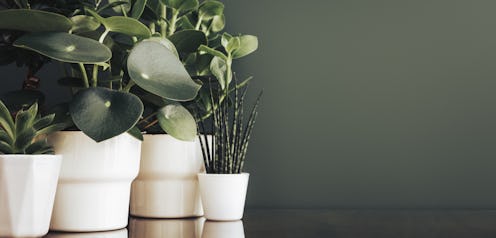
If you're a plant person, summer can be the most challenging time to keep your little guys happy and healthy. Brighter, more direct sunlight can have its affect on plants, as can the rise in humidity in the air. Keeping each individual type of house plant alive is dependant on that plant's needs, and the following short but sweet guide will help you know how to keep your house plants alive in hot weather. Keep reading to discover the main things you should consider when temperatures are soaring.
First things first, sunlight. Each plant requires a different level of sunlight, and during the summer months, those that prefer shade may suffer. Patch Plants explains that plants with dry soil, or crisped, baked leaves may be experiencing too much sunlight, and could benefit from less intense light and more shade.
The best way to rectify this is to learn what your plant actually requires in terms of sunlight. Here is a helpful list of the plants that do and do not like direct sunlight:
Plants that like lots of sunlight:
- Fiddle leaf fig trees
- Yucca elephantipes
- Cacti
- Succulents
- Anthuriums
Plants that prefer shade:
- Peace lilies
- Calatheas
- Fern plants
- Spider plants
- Swiss cheese plant
Some plants actually like a lot of sunlight, but just indirectly. As long as you read up on your particular plant's needs, you should be able to place it where it's happiest.
Secondly, water. Knowing how often to water plants and how much water you should be giving them is probably the biggest minefield for new plant owners. If you own lots of different types of plants, you'll need to cater to their individual needs. This useful list shows which plants need regular showers (usually those that come from rainforest habitats), and which do not (think drier, desert-dwelling plants such as succulents).
Plants that need regular watering in summer:
- Calathea
- Bird of paradise
- Rhipsalis
- Elephant ear plant
- Parlour palm
Plants that require less water:
- Cacti
- Succulents
- Golden pathos
- Snake plant
- Ceropegia woodii
In the hot weather, plants often require more regular watering, as soil dries up more quickly and plants become far more thirsty. Check for dry curling leaves, as this may be a sign they aren't being watered enough. Ensure you give them a good drink, or for plants really struggling, move them into the bathroom where they will have more natural moisture in the air.
Beware of over-watering however, this can be just as dangerous as under-watering. Signs of over-watering include yellowing or droopy leaves. The best way to know if your plant needs a water is simply to feel the soil; if it's still damp, it's best to leave it until it feels dry again.
Thirdly, holidays. For dedicated plant owners, going on holiday in the warmer summer months can be particularly stressful. The best solution is of course to ask a friend to pop by on a weekly basis and check in on your plants. If that isn't an option, however, there are other alternatives.
For one, you could invest in a water bulb, which slowly distributes water into your plant's soil over a period of time. You could also pop a cloth into the soil of your plant, with the other end dipped into a bowl of water; the plant will suck up water as and when it needs a drink.
All in all, plants are there to be enjoyed, so try not to stress too much about keeping them alive; just be a little more alert when the temperatures are at extremes.